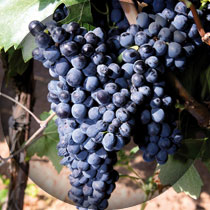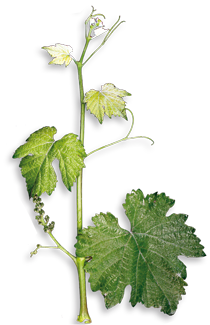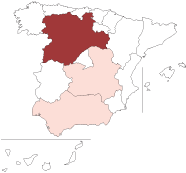Prieto Picudo (ES)
Variety: red | Category II | Spain


General Information
Prieto Picudo


Origin: This variety probably originated in the North-West of Castile and Leon, North of Valladolid. Although no precise references exist, it is thought that the variety came from Portugal.
Chief areas of distribution: Castile and Leon.
Official synonym(s) (national and OIV): None.
Historic and regional synonyms: Prieto Picudo Tinto.
Homonym(s): None.
Area under cultivation: 5,000 ha (Ministry of Agriculture, 2007).
Trend: Upward, in terms of quality.
Varietal variability: Medium to low.
Availability of propagating material: Certified clones (CL-9, CL-31, CL-58, CL-110, CL-116).
Molecular Profile (OIV)
Regional Classification
Morphology
Phenology
Vegetative Potential
Viticultural Parameters
Oenology
Variety Characteristics
| VVMD5 | VVMD7 | VVMD27 | VrZag62 | VrZag79 | VVS2 | ||||||
| Allele1 | Allele2 | Allele1 | Allele2 | Allele1 | Allele2 | Allele1 | Allele2 | Allele1 | Allele2 | Allele1 | Allele2 |
| 232 | 236 | 237 | 237 | 177 | 181 | 187 | 187 | 241 | 245 | 130 | 142 |
Recommended in Portugal: Castilla La Mancha.
Authorized: Andalucía, Asturias, Castilla La Mancha.
DOC quality wine: DO Tierra de León.
Young shoot (form of tip): Open, very dense erect hairs, weak anthocyanin colouration.
Young leaf: Very dense prostrate hairs, medium to strong anthocyanin colouration.
Young shoot: Green with red stripes on the dorsal and ventral sides, sparse hairs on internodes.
Inflorescence (sex of flower): Hermaphrodite.
Mature leaf: Large pentagonal blade, five deeply notched slightly overlapping lobes, slightly open U-shaped petiolar sinus, high colouration of veins at first ramification, medium prostrate hairs and spare erect hairs between veins on lower side of blade. Very sparse hairs on petiole. Teeth convex on both sides, medium length-width ratio.
Bunch: small, dense, short peduncle.
Berry: Small, even, blue-black epidermic, globose, difficult to detach, colourless soft flesh.
Woody shoot: Yellowish brown with stripes.
Time of bud burst: Normal.
Flowering: Normal.
Berry (colour change): colour change: Normal to late.
Berry (harvest ripe): Normal.
Vigour of shoot growth: High.
Pruning weight:: Medium to low.
Shoot attitude (habit): Semi-erect, plagiotropic tendency.
Length of internodes: Very long.
Shoot length: Medium.
Tendency to form lateral shoots: No, or very low tendency.
Rate of multiple bud bursts: Hardly ever occurs (depends on the age of the vine.)
Bud fertility index: Low to medium fertility with only one bunch per shoot.
Yield consistency: Low.
Crop uniformity: Lacks uniformity.
Winkler Index: 3-4 (on a scale of 1 to 5).
Sensitivity to abiotic factors: Low drought resistance, sensitive to extreme solar radiation.
Susceptibility to fungal diseases: Sensitive to Oidium.
Susceptibility to Pests: Low.
Bunch weight: Medium to small.
Berry size: Small – medium.
Seeds per berry: 4-5.
Vineyard conduction system: Double cordon.
Pruning: Long shoots.
Green pruning: Not absolutely necessary, but interesting from a qualitative point of view.
Soil requirement: Prefers open soils.
Climatic requirements: Mild.
Vine density: In Iberia, a maximum of 2,500 vines/ha.
Rootstock: Incompatibility not yet determined.
Incidence of coulure/millerandage: Yes.
Spoilage of mature berries: Very minimal.
Risk of bird damage: No particular risk.
Machine harvest suitability: Very good.
Hand harvest suitability: Difficult because of variety's small bunches, and dense foliage.
Wine type: Suitable for red and rosé wines.
Potential alcohol content: High sugar concentration.
Natural acidity of must: 7 g/l acid; therefore, much more than the Tempranillo.
Total anthocyanins: High.
Risk of oxidation of must: Low to non-existent.
Tendency towards acidity loss in fermentation: Usually not.
Colour intensity of wine: Medium to high.
Wine colour tonality: slight tendency towards violet.
Tannins: Medium to high.
Total polyphenol index (at 280 nm): 50.
Risk of oxidation of wine: Risk of oxidation.
Aromatic profile: Very pleasant fruity accents, distinctive aroma.
Ageing Potential: Very good.
Blending recommendation: Because of the high quality of this varietal, blending holds little interest. Good results have been achieved with the Méncia and Tempranillo.
Wine Descriptors: Alcohol rich wine, cherry coloured with violet tones. Very aromatic with wild fruit notes, black pepper aroma, high acid. Sustained palate with retro-nasal aromas.
Wine quality: A valuable grapevine variety from a quality point of view.

